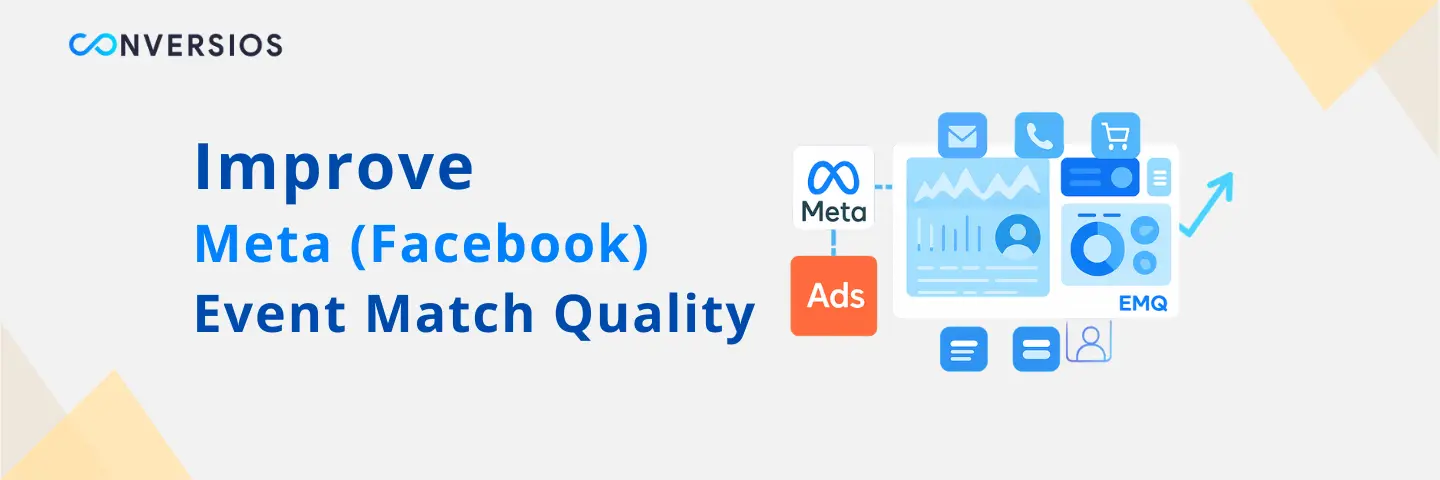How to Increase Your Event Match Quality (EMQ) for Facebook Ads Without Manual Coding
If you’re running Facebook or Meta Ads and noticing that conversions aren’t adding up, your Event Match Quality (EMQ) score might be the reason behind the mismatch.
EMQ is Meta’s internal score that reflects how well your event data aligns with real user profiles across Facebook and Instagram. The higher your EMQ, the better your ad performance. A strong score helps Meta match clicks to conversions, improve targeting accuracy, and optimize your ad spending more efficiently.
Each event, like Add to Cart or Purchase, can carry customer data such as email, phone number, location, or browser ID. When this data is clean and complete, your EMQ improves—and so does your return on ad spend.
What Is Event Match Quality and Why It Matters
Meta evaluates EMQ on a scale of 0 to 10. The closer your score is to 10, the easier it becomes for Facebook to connect events to actual users. This score depends on identifiers like:
- Email address
- Phone number
- First and last name
- City, state, ZIP
- FBC and fbp browser IDs
Missing or incomplete details make it harder for Facebook’s system to match your events to users, which results in underreported conversions and less effective ad delivery.
Why Low EMQ Hurts Your Facebook Campaigns
Let’s say your store registers 68 purchases, but Facebook only shows 40. That gap is often caused by poor event matching.
Low EMQ typically leads to:
- Missed conversion tracking
- Wasted ad budget due to inaccurate targeting
- Limited ability to optimize campaigns or create high-performing lookalike audiences
This problem is more severe on privacy-restricted platforms like iOS and browsers like Safari. In these cases, Facebook can’t track users properly unless your EMQ is high enough to connect the dots.
4 Common Mistakes That Lower EMQ
Most marketers don’t realize how easy it is to sabotage their EMQ. The most common mistakes include:
- Missing customer data : Not passing basic identifiers like email or phone number with events.
- Relying only on client-side tracking: Events tracked through the browser can get blocked or lost, especially on iOS.
- Improper event deduplication: If you’re using both Facebook Pixel and Conversions API but haven’t set up deduplication correctly, Meta may record duplicate events or fail to count them altogether.
Manual setup issues: Coding errors, formatting mismatches, or partial parameter mapping can all drag your score down.
How EMQ Fits Into Your Full Funnel Strategy
Many advertisers only worry about EMQ when it comes to final conversions like purchases. But EMQ matters throughout the customer journey.
If your ViewContent, Add to Cart and Initiate Checkout events also include well-matched customer data, Meta can:
- Attribute conversions more accurately
- Train its algorithms faster in the learning phase
- Deliver ads to higher-value audiences
- Improve your retargeting and lookalike performance
EMQ isn’t just about one number. It’s about creating a complete picture of how real users move through your funnel.
The No-Code Way to Boost EMQ with Conversios
You don’t need a developer or manual Google Tag Manager setup to improve EMQ.
Conversios takes care of the entire backend:
- One-click activation of Facebook’s Conversions API
- Prebuilt GTM templates with event deduplication already configured
- Automatic capture of customer parameters like name, email, and phone
- Server-side delivery of events to avoid browser and cookie limitations
- Support for first-party cookies to improve tracking durability
Whether you use Shopify or WooCommerce, setup takes less than five minutes. No coding required. With Conversios, you can also boost EMQ by improving your customer match quality.
Real Results from Users Who Improved Their EMQ
One Shopify store using Conversios saw its EMQ score rise from 5.4 to 8.7 in just one week. After improving their event match signals, they saw:
- A 28% increase in ROAS
- A 19% drop in cost per conversion
- More precise retargeting across meta-channels
This wasn’t luck. It was the result of better signals and smarter attribution.
Final Thoughts
Event Match Quality isn’t just another metric. It’s the foundation for getting your budget’s worth on Facebook Ads.
Instead of relying on fragile browser tracking, give your campaigns the solid, server-side data foundation they deserve.
With Conversios, it’s easier than ever to improve your EMQ, get more conversions, and spend smarter. If you’re comparing tools, check out our top Google Ads plugins for WooCommerce.
Q: Where can I check my EMQ score?
Go to Facebook Events Manager, select your Pixel, and view the score next to each event name.
Q: I already use Facebook Pixel. Do I need CAPI too?
Yes. The Pixel often misses events due to browser restrictions. CAPI delivers data directly from your server, ensuring higher match quality.
Q: Do I need a developer to set this up?
No. Conversios provides everything out of the box. Setup is fast, automated, and doesn’t require any coding.
Q: Can I improve EMQ on a budget?
Absolutely. You don’t need a data team or a developer. Conversios handles all the technical tracking setups for you.
Q: What’s the difference between Match Rate and EMQ?
Match Rate shows how many events Facebook can match to users. EMQ reflects the quality and depth of the data in each event. You need both to run effective ads.
Q: How does EMQ affect Facebook’s learning phase?
High EMQ gives Facebook better data, which shortens the learning period and improves ad optimization. Low EMQ can stall your campaigns in early phases.

